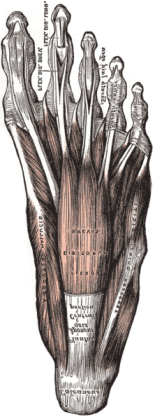You are here
Optimal Cushioning For Your Feet
Few health challenges are as frustrating and slow-to-heal as plantar fascitis. Since feet are rarely given time to completely rest, many sufferers experience gnawing pain for several months, and in some cases, years.
 Imagine your feet as two tennis racquets with the strings of the racquets supporting your full body weight. The strings represent the tissues that stretch along the soles of your feet and make up your plantar fascia. If you put too much pressure on these tissues for long enough, you are highly likely to eventually develop plantar fascitis.
Imagine your feet as two tennis racquets with the strings of the racquets supporting your full body weight. The strings represent the tissues that stretch along the soles of your feet and make up your plantar fascia. If you put too much pressure on these tissues for long enough, you are highly likely to eventually develop plantar fascitis.
Logically, the most common cause of chronic plantar fascitis is being overweight. If you can imagine every ten pounds of excess body weight being a large watermelon or a sack of potatoes that your feet have to carry around at all times, it's easy to visualize the direct relationship between body weight and plantar fascia health.
Another common cause of plantar fascitis is regular use of uncomfortable footwear. Consider that the average person walks around 5 miles per day, translating to 8,000 to 10,000 steps daily. Multiply this by decades, and it becomes exceedingly clear that the more cushion and support offered by your shoes, the better off your plantar fascia and feet are. Actually, it's not a stretch to say that comfortable footwear can help prevent development of foot, ankle, knee, hip, and back pain, as the state of every joint in your body is intimately connected to the health of adjacent joints.
In the past, I've made recommendations on shoes, sandals, and more formal footwear that provide a good blend of comfort and support - you can review this information via the following links:
Shoes and Sandals for Healthy Feet
Comfortable Dress Shoes for Healthy Joints
Another way to provide substantial cushioning for your feet and joints is to utilize an inexpensive heel support. There are many varieties on the market that I've tested over the past couple of years, and the ones that I have found to be most effective are inexpensive options made by Dr. Scholl's:
Dr. Scholl's Massaging Gel Heel Cushions - If you use these daily, which is what I recommend to help prevent plantar fascitis, you can expect to replace them a few times a year. It's simple to move them from shoe to shoe, and they don't add bulk to the arch area, which I find is best for people who already have healthy arches.
Dr. Scholl's Arthritis Pain Relief Orthotics - These are a good choice if you can use heel cushioning plus arch support. They're made of a soft foam material rather than gel, and tend to stay firmly in place once in your shoes. If you have severe heel pain and find that just the foam of these orthotics isn't enough to provide significant relief, try doubling up by adding the Gel Heel Cushions mentioned above on top of these orthotics.
There's a line of more expensive supportive insoles called "Superfeet," available in various colors with each color representing different levels of support to correspond with varying arches and needs; this line tends to get high praise from users, but I have to say that my experience has been that they don't offer the same level of pure cushioning that the less expensive varieties by Dr. Scholl's do. I have found this to be true with personal testing as an avid tennis player, and consistently across the board with clients who have utilized these products.
But because "Superfeet" orthotics consistently receives high praise from the general public, here is the link to their green, "thicker profile" version in case you'd like to check them out:
One treatment measure that I recommend to all clients who have plantar fascitis is to use a knobby foam roller to massage the plantar fascia of both feet throughout the day. Rolling the soles of your feet over a knobby foam roller is a safe and effective way of improving blood circulation in the area, which accelerates healing. Rolling can also help break up scar tissue that may be impeding optimal function of the ligaments and muscles in this area.
The knobby therapeutic foam roller that I have my clients use for plantar fascitis can be found here:
If you have any questions on this topic, please feel free to send me a message using our contact form here:
Most of us don't consider preventive measures until we develop inflammation and have enough day-to-day pain to seek treatment. In the case of plantar fascitis, bone spurs in the heel region, and other health challenges associated with feet that are overly stressed, the price of neglect often has to be paid over a frustratingly long period, so please consider these thoughts the next time you purchase footwear. And if you already have heel pain, perhaps it's time to consider using simple heel supports.






